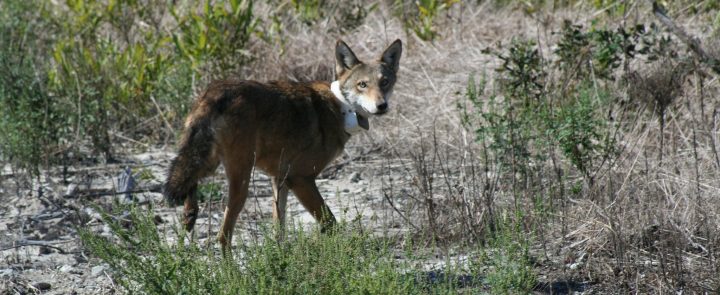
WASHINGTON, D.C. — In an apparent concession to waning political and public support, the U.S. Fish and Wildlife Service on Wednesday announced a proposed rule that would no longer manage endangered red wolves on private land in northeastern North Carolina.
The action would reduce the animals’ range from 1.7 million acres to 204,000 acres.
Supporter Spotlight
But the agency would still continue protecting red wolves under the Endangered Species Act within federal lands in the Alligator River National Wildlife Refuge and the Dare County Bombing Range in Dare and Hyde counties under the proposal.
“We’re going to be managing this population intensely,” Leopoldo Miranda, assistant regional director for ecological services at Fish and Wildlife’s Southeast Region, said during a press conference.
If the rule is finalized, red wolves outside the proposed range would no longer have federal protection from being intentionally killed.
Supporter Spotlight
Miranda said the successful adaptive management practices that had helped control coyotes and encourage wild wolf mothers to adopt captive pups would be re-implemented where appropriate. The agency will also be looking for additional areas to expand within the red wolf’s historic range in southeastern states, he said, although he declined to specify which states or regions are being considered.

As it is now, he added, current conditions in northeastern North Carolina are not self-sustaining for the wolves. Miranda said that under the proposal, the agency would focus more on propagation of red wolves so that their wild behaviors strengthen the genetic integrity of the offspring.
Only 35 or so red wolves still survive in the wild within the current designated recovery area in Hyde, Tyrrell, Washington, Beaufort and Dare counties, down from a peak of about 130 in 2006. Of those, about 10 to 15 wolves, or about two packs, live in the proposed area. About 200 wolves also live in captivity in various facilities.
“Success is to keep this smaller population, as much as possible, on federal land,” Miranda said, adding that the agency will adapt the program as science provides more insight.
But Kim Wheeler, executive director of the Red Wolf Coalition, a 40,000-member nonprofit based in Columbia, in Tyrrell County, said she is worried that the small amount of land and the decreased protection provided in the proposed rule will hinder the red wolf’s chances.

“I don’t know if this gives the red wolf a clear path for survival in the wild,” she said. “It’s discouraging all around, but we don’t want red wolf supporters and advocates to give up.”
Once hailed as a bold, innovative conservation success story, the red wolf recovery program fell apart with stunning speed. First listed as endangered in 1967, red wolves were declared extinct in the wild in 1980. Four pairs of captive wolves were transferred in 1987 to the Alligator River refuge, and in 1995 the agency finalized a plan to manage what it called the “nonessential, experimental population” in the designated five-county recovery area.
That’s around the same time Fish and Wildlife may have made a fatal oversight by not communicating in advance with private landowners, many of whom operate farms or use their land for recreational hunting.
“Once those animals were released and they left the refuge, they came to visit with me, because that’s where the food was,” said Wilson Daughtry, owner of Alligator River Growers and part-owner of Lux Farms, both in Engelhard. “And we couldn’t do anything about it.”
Roaming predators crossing private land is not unusual in rural northeastern North Carolina, with its vast populations of bear, fox, coyotes and other wildlife. What is different about the red wolves is they are federally protected, and by law cannot be harmed.
As a consequence, Daughtry said, if a red wolf came onto his property and destroyed his crops, his right to defend his property was superseded by the wolf’s federal status. But the recovery program was already in place when landowners started seeing red wolf interlopers.
“You basically put something here that we didn’t ask for and we didn’t want,” he said. “To me, that is the root of the whole problem – and it only got worse.”
Intentional killings by gunshots and poisoning, in addition to hybridization with coyotes, quickly became the program’s biggest challenges. Between 2003 and 2011, for instance, 80 red wolves had been shot.

Jett Ferebee, a Tyrrell County landowner, has been one of the most vocal opponents of the red wolf program, hammering politicians and agency officials in numerous letters and public comments about what he contends are “coy-wolves” that decimate deer and rabbit populations and don’t deserve government protection.
But to Daughtry, it’s a private property issue more than anything. Not everyone objects to red wolves on their land, he said, but everyone should have a right to say so. Once the landowners started complaining loud enough, Daughtry said, the federal government offered them “a very small amount” of money, or “pandering to try to appease us,” as he saw it.
“They came to us as a way to see if we could work something out,” he said. “In all honesty, that’s what they should have done in the beginning, instead of waiting until everybody was pissed off.”
But Daughtry said it’s a “shame” the program hadn’t worked out, and he blamed upper management, not the local staff. The bottom line, he said, is that the agency should have known the wolves wouldn’t stay put in the refuge, and it should have offered something like lease-hold rights to private property owners as compensation.
“No landowner in their right mind is going to agree to have an endangered wolf on their land without some kind of safety net,” he said.
The agency also has its critics in non-governmental organizations within the conservation community for pulling back from protection of the species.

“Under the new plan, any wolves that either remain or wander outside of the greatly reduced recovery area would lose all federal protection, unless they stay on other national wildlife refuges in the region,” Ron Sutherland, conservation scientist for Wildlands Network, said in a prepared statement. “Otherwise, hunters and landowners would be allowed to kill red wolves with no repercussions, apart from a request from FWS to return the radio-collars from dead animals.”
Sutherland also said that there is tremendous public support for recovery of the red wolves, with only 10 of a total of 55,000 comments submitted to the agency favoring elimination of the program.
In moving forward, Miranda acknowledged that mistakes were made, and vowed that the agency will improve communication.
“I will ask the community and the NGOs (non-governmental organizations) to help us manage the conservation of the species,” he said. “I am the first one to say, ‘Yeah, that’s probably true that we dropped the ball in terms of working with landowners.’ This is not just a Fish and Wildlife effort. We know we cannot conserve this species – or any species – by ourselves.”







